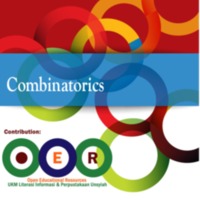Combinatorics
Dublin Core
Title
Subject
Description
Combinatorics is a subfield of "discrete mathematics," so we should begin by asking what discrete mathematics means. The differences are to some extent a matter of opinion, and various mathematicians might classify specific topics differently.
"Discrete" should not be confused with "discreet," which is a much more commonly-used word. They share the same Latin root, "discretio," which has to do with wise discernment or
separation. In the mathematical "discrete," the emphasis is on separateness, so "discrete" is the opposite of \continuous." If we are studying objects that can be separated and treated as a (generally countable) collection of units rather than a continuous structure, then this study falls into discrete mathematics.
In calculus, we deal with continuous functions, so calculus is not discrete mathematics. In linear algebra, our matrices often have real entries, so linear algebra also does not fall into discrete mathematics.Text books on discrete mathematics often include some logic, as discrete mathematics is often used as a gateway course for upper-level math. Elementary number theory and set theory are also sometimes covered. Algorithms are a common topic, as algorithmic techniques tend to work very well on the sorts of structures that we study in discrete mathematics.
In Combinatorics, we focus on combinations and arrangements of discrete structures. There are have major branches of combinatorics that we will touch on in this course: enumeration,
graph theory, Ramsey Theory, design theory, and coding theory. (The related topic of cryptography can also be studied in combinatorics, but we will not touch on it in this course.) We will
focus on enumeration, graph theory, and design theory, but will briey introduce the other two topics.
"Discrete" should not be confused with "discreet," which is a much more commonly-used word. They share the same Latin root, "discretio," which has to do with wise discernment or
separation. In the mathematical "discrete," the emphasis is on separateness, so "discrete" is the opposite of \continuous." If we are studying objects that can be separated and treated as a (generally countable) collection of units rather than a continuous structure, then this study falls into discrete mathematics.
In calculus, we deal with continuous functions, so calculus is not discrete mathematics. In linear algebra, our matrices often have real entries, so linear algebra also does not fall into discrete mathematics.Text books on discrete mathematics often include some logic, as discrete mathematics is often used as a gateway course for upper-level math. Elementary number theory and set theory are also sometimes covered. Algorithms are a common topic, as algorithmic techniques tend to work very well on the sorts of structures that we study in discrete mathematics.
In Combinatorics, we focus on combinations and arrangements of discrete structures. There are have major branches of combinatorics that we will touch on in this course: enumeration,
graph theory, Ramsey Theory, design theory, and coding theory. (The related topic of cryptography can also be studied in combinatorics, but we will not touch on it in this course.) We will
focus on enumeration, graph theory, and design theory, but will briey introduce the other two topics.
Creator
Contributor
Cut Rita Zahara
Rights
Creative Commons
Type
Files
Collection
Citation
Joy Morris, “Combinatorics,” Open Educational Resources (OER) , accessed January 10, 2026, http://oer.uinsyahada.ac.id/items/show/365.


